Offline
Hey all, my journey continues. After finally getting the ‘73 midget running, I wanted to take it for a spin to see how the transmission was. I tried to get it into gear but the clutch went straight down to the floor with no resistance so I knew I wasn’t going to go far. I still had to try and or course I could not get the car into gear. I decided to replace the master, slave, and the hose to make sure I knew the condition of everything. While removing the hydraulic hose, I noticed the copper pipe was broken so I replaced that too.
I bought this kit from Moss Motors - master slave kit
I bought this pipe from Moss Motors - pipe
I bought the One Man Bleeder from Moss Motors - One Man Bleeder
I took out then pedal box, brake and clutch masters, and pedals cleaned them all up to new metal installed new brake and clutch masters on the pedal box, and put it back in the car, attaching the old springs to the pedals (I’ve bought new ones, just didn’t install them). I bent and ran the new pipe in the proper place, attaching it to the new hose which was connected to the new slave. I added remote bleeder to make it easier to bleed. All items were installed and all fittings are tight. I added Dot 4 fluid to the master and pumped the clutch, fluid did not move at all from the reservoir on the master. I made sure the bleeder was open and tried again, still no luck. I removed the pipe fitting from the master and pumped the clutch pedal to see very little if any fluid coming out. I eventually was able to get the fluid through the system using a shop vac attached to the bleeder valve until I pulled fluid through. Attached the one man bleeder to the bleeder and followed all the steps this video to bleed the line (when they switched to the one man bleeder). I could get the fluid to go into the tube of the one man bleeder, slightly past the black part of the tubing, but never all the way. Clutch pedal still went to floor.
I followed the steps in this video performing the pushing part 5 times, and not just four as the video suggests. Put the small socket in, pressed the clamp on, tried to pump the pedal (which according to the video shouldn’t move) and the pedal went to the floor. I’m stumped. Is there still air in the system? What should I do now?
I bought this kit from Moss Motors - master slave kit
I bought this pipe from Moss Motors - pipe
I bought the One Man Bleeder from Moss Motors - One Man Bleeder
I took out then pedal box, brake and clutch masters, and pedals cleaned them all up to new metal installed new brake and clutch masters on the pedal box, and put it back in the car, attaching the old springs to the pedals (I’ve bought new ones, just didn’t install them). I bent and ran the new pipe in the proper place, attaching it to the new hose which was connected to the new slave. I added remote bleeder to make it easier to bleed. All items were installed and all fittings are tight. I added Dot 4 fluid to the master and pumped the clutch, fluid did not move at all from the reservoir on the master. I made sure the bleeder was open and tried again, still no luck. I removed the pipe fitting from the master and pumped the clutch pedal to see very little if any fluid coming out. I eventually was able to get the fluid through the system using a shop vac attached to the bleeder valve until I pulled fluid through. Attached the one man bleeder to the bleeder and followed all the steps this video to bleed the line (when they switched to the one man bleeder). I could get the fluid to go into the tube of the one man bleeder, slightly past the black part of the tubing, but never all the way. Clutch pedal still went to floor.
I followed the steps in this video performing the pushing part 5 times, and not just four as the video suggests. Put the small socket in, pressed the clamp on, tried to pump the pedal (which according to the video shouldn’t move) and the pedal went to the floor. I’m stumped. Is there still air in the system? What should I do now?

 Hi Guest!
Hi Guest!

 smilie in place of the real @
smilie in place of the real @
 Pretty Please - add it to our Events forum(s) and add to the calendar! >>
Pretty Please - add it to our Events forum(s) and add to the calendar! >> 




